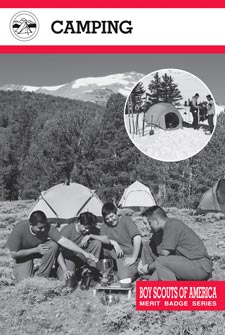This Merit Badge is Required
to earn the Eagle Scout Rank
- Show that you know first aid for and how to prevent injuries or illnesses that could occur while camping, including hypothermia, frostbite, heat reactions, dehydration, altitude sickness, insect stings, tick bites, snakebite, blisters, and hyperventilation.
- Learn the Leave No Trace principles and the Outdoor Code and explain what they mean. Write a personal and group plan for implementing these principles on your next outing..
- Make a written plan for an overnight trek and show how to get to your camping spot using a topographical map and compass and a GPS receiver. If no GPS receiver unit is available, explain how to use one to get to your camping spot.
- Do the following:
- Make a duty roster showing how your patrol is organized for an actual overnight campout. List assignments for each member.
- Help a Scout patrol or a Webelos Scout unit in your area prepare for an actual campout, including creating the duty roster, menu planning, equipment needs, general planning, and setting up camp.
- Do the following:
- Prepare a list of clothing you would need for overnight campouts in both warm and cold weather. Explain the term "layering."
- Discuss footwear for different kinds of weather and how the right footwear is important for protecting your feet.
- Explain the proper care and storage of camping equipment (clothing, footwear, bedding).
- List the outdoor essentials necessary for any campout, and explain why each item is needed.
- Present yourself to your Scoutmaster with your pack for inspection. Be correctly clothed and equipped for an overnight campout.
- Do the following:
- Describe the features of four types of tents, when and where they could be used, and how to care for tents. Working with another Scout, pitch a tent.
- Discuss the importance of camp sanitation and tell why water treatment is essential. Then demonstrate two ways to treat water.
- Describe the factors to be considered in deciding where to pitch your tent.
- Tell the difference between internal- and external-frame packs. Discuss the advantages and disadvantages of each.
- Discuss the types of sleeping bags and what kind would be suitable for different conditions. Explain the proper care of your sleeping bag and how to keep it dry. Make a comfortable ground bed.
- Prepare for an overnight campout with your patrol by doing the
following:
- Make a checklist of personal and patrol gear that will be needed.
- Pack your own gear and your share of the patrol equipment and food for proper carrying. Show that your pack is right for quickly getting what is needed first, and that it has been assembled properly for comfort, weight, balance, size, and neatness.
- Do the following:
- Explain the safety procedures for:
- Using a propane or butane/propane stove
- Using a liquid fuel stove
- Proper storage of extra fuel
- Discuss the advantages and disadvantages of different types of lightweight cooking stoves.
- Prepare a camp menu. Explain how the menu would differ from a menu for a backpacking or float trip. Give recipes and make a food list for your patrol. Plan two breakfasts, three lunches, and two suppers. Discuss how to protect your food against bad weather, animals, and contamination.
- Cook at least one breakfast, one lunch, and one dinner for your patrol from the meals you have planned for requirement 8c. At least one of those meals must be a trail meal requiring the use of a lightweight stove.
- Explain the safety procedures for:
- Show experience in camping by doing the following:
- Camp a total of at least 20 days and 20 nights. Sleep each night under the sky or in a tent you have pitched. You may use a week of long-term camp toward this requirement. If the camp provides a tent that has already been pitched, you need not pitch your own tent.
- On any of these camping experiences, you must do TWO of the
following, only with proper preparation and under qualified
supervision:
- Hike up a mountain, gaining at least 1,000 vertical feet.
- Backpack, snowshoe, or cross-country ski for at least 4 miles.
- Take a bike trip of at least 15 miles or at least four hours.
- Take a nonmotorized trip on the water of at least four hours or 5 miles.
- Plan and carry out an overnight snow camping experience.
- Rappel down a rappel route of 30 feet or more.
- Perform a conservation project approved by the landowner or land managing agency.
- Discuss how the things you did to earn this badge have taught you about personal health and safety, survival, public health, conservation, and good citizenship. In your discussion, tell how Scout spirit and the Scout Oath and Law apply to camping and outdoor ethics.
A footnote to Requirement 7, reading "May be part of a Troop trip" was in earlier editions of the Requirements Book, but no longer appears in the current edition. However, although not specifically stated in the requirements, if the troop goes on a trip, and the Patrol method is used (or if there is only one patrol) that campout can be used to meet requirement 7.
BSA Advancement ID#:
1
Requirements last updated in:
2006
Pamphlet Stock Number:
33256B
Pamphlet Revision Date:
2005
| Worksheets for use in working on these requirements: | Prepared by Craig Lincoln |
Format | |
|---|---|---|---|
| Word Format | PDF Format | ||
Page updated on: May 08, 2022









